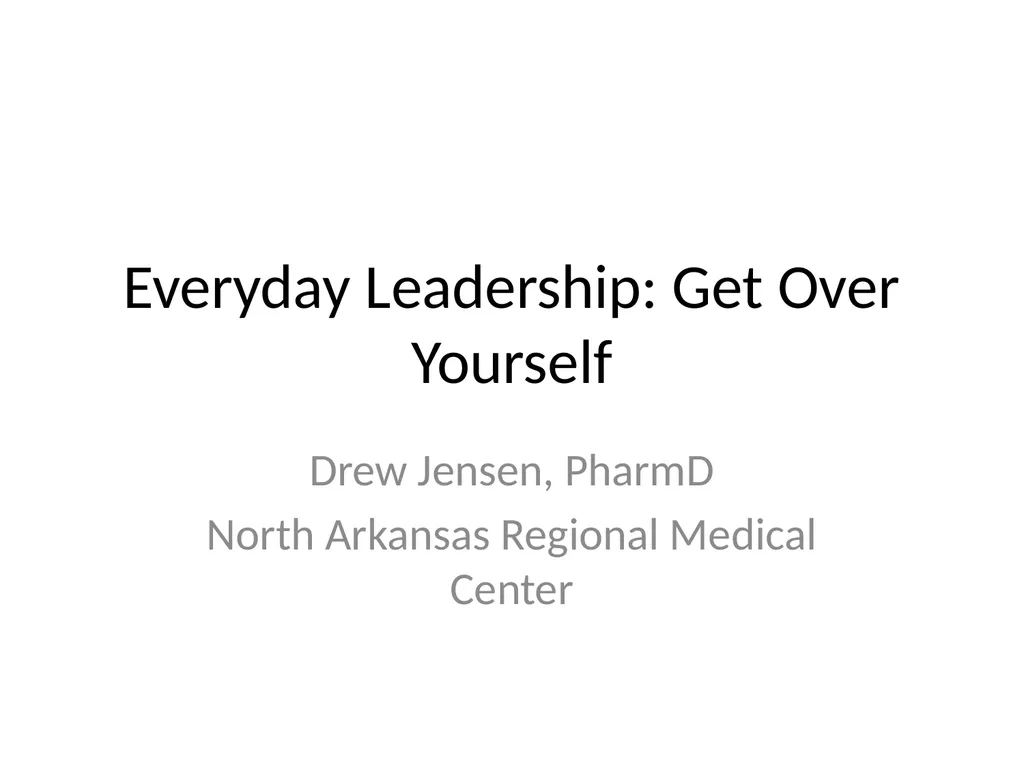Everyday Leadership: Get Over Yourself Drew
Author : olivia-moreira | Published Date : 2025-05-24
Description: Everyday Leadership Get Over Yourself Drew Jensen PharmD North Arkansas Regional Medical Center Disclosure The presenters have no conflicts of interest real or apparent and no financial interests in any company product or service to
Presentation Embed Code
Download Presentation
Download
Presentation The PPT/PDF document
"Everyday Leadership: Get Over Yourself Drew" is the property of its rightful owner.
Permission is granted to download and print the materials on this website for personal, non-commercial use only,
and to display it on your personal computer provided you do not modify the materials and that you retain all
copyright notices contained in the materials. By downloading content from our website, you accept the terms of
this agreement.
Transcript:Everyday Leadership: Get Over Yourself Drew:
Everyday Leadership: Get Over Yourself Drew Jensen, PharmD North Arkansas Regional Medical Center Disclosure The presenters have no conflicts of interest, real or apparent, and no financial interests in any company, product, or service to disclose. Pharmacist Objectives Identify your organization’s stage of culture based on the tribal leadership model. Describe the characteristics of each of the five stages of tribal culture. Recognize and implement strategies that will enable the tribe to upgrade its culture. Technician Objectives Describe how to determine your company’s stage of culture using the tribal leadership model Discuss the five stages of tribal culture. Examine strategies to help the tribe to upgrade its culture (to trade one set of values for another). Defining a Tribe Any group of people between 20 and 150 Would stop and say “hello” if they saw each other walking down the street Likely people in your cell phone contact list Small company = tribe Large company = tribe of tribes Identifying Your Tribe’s Stage Individual assessment At your workplace, think about how most people talk most people structure their relationships 5 minutes The Rules Every tribe has its own way of speaking (dominant culture), which can be pegged on a 1 to 5 scale Stage 5 > 4 > 3 > 2 > 1 People and groups can only advance one stage at a time Person in stage # (not a “stage # person”) 5 Tribal Stages Identifying the Tribal Stage Based on two factors Language used by the tribe Structure of relationships within the tribe Role of Tribal leader Listen for which culture exists in the tribe Upgrade the tribe using specific leverage points Stage 1: On the Verge of a Meltdown Language “Life sucks” May be acts of violence or extreme verbal abuse Structure Isolated gangs that operate by their own rules Often based on absolute loyalty to the group 2% of workplace tribes Stage 2: Disconnected & Disengaged Language “My life sucks” Apathetic victims; no initiative or passion Endless well of complaints, unmet needs Structure Cluster together in groups that encourage passive aggressive behavior 25% of workplace tribes Stage 3: The Wild West Language “I’m great (and you’re not)” People talk mostly about themselves; focus appearing smarter and better than others Structure “Lone warriors” forming dyadic (two-person) relationships Rarely bring people together 49% of workplace tribes Stage 4: The Zone of Tribal Leadership Language “We’re great (and they’re














